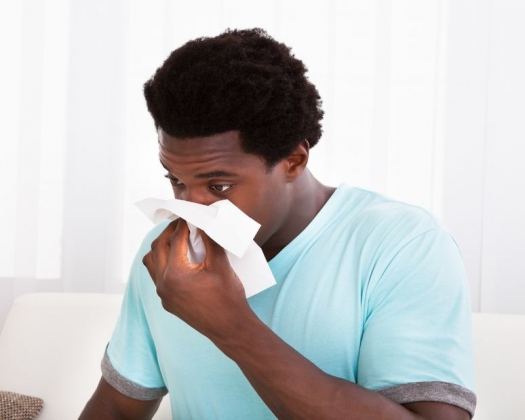Achoo! This is a common sound you and I are hearing these days, sometimes from ourselves. Seasonal allergies affect one in six Americans, at an annual cost of over $18 billion, and four million lost work days. (1, 2) An allergy is an exaggerated immune response or reaction to substances that are generally not harmful. Exposure with an allergen is through the lungs, skin or gut, or injections, often vaccines. Most seasonal allergies are from respiratory exposure, usually to tree, grass or weed pollen.
How do I know I have allergies?
Common symptoms of seasonal allergies include itching of the nose, mouth, throat or skin; swelling or puffiness; mucus and phlegm production; hives (urticaria); skin rashes; breathing problems (coughing, shortness of breath, wheezing); burning, tearing or itchy eyes; conjunctivitis (red, swollen eyes); cough; headache.
Drugs for symptoms
Conventional medicine claims that there is no cure for allergies. In mainstream medicine the only approach is minimizing allergen exposure, and taking drugs to suppress symptoms. These include antihistamines, e.g. Benadryl, Claritin, Allegra, Zyrtec; corticosteroids, e.g. cortisone, prednisone, dexamethasone; decongestants, e.g. sudafed, dimetapp, visine, neosynephrine; leukotriene inhibitors, e.g. Singulair, Accolate, Zyflo; and allergy shots (immunotherapy/desensitization). Total sales of these drugs is over $18 billion per year. While sometimes necessary when less toxic approaches are not enough, relying on drugs alone to address allergy symptoms is at best limited, and potentially dangerous, given the side effects of the drugs and the cumulative toxicity of taking any pharmaceuticals daily.
The nine contributors to allergies
Wholistic healthcare, unlike reductionist medicine, looks for contributors to wellness and illness, rather than single causes of disease. What differentiates wholistic from reductionist medicine is root cause resolution. Instead of merely suppressing symptoms or managing disease, wholistic care seeks to address the specific causes and triggers of illness, most of which are in our lifestyle choices, and removing those blocks to our natural expression and experience of well-being.
All allergies
- Alkalosis
- Liver toxicity/congestion
- Adrenal insufficiency
- Poor sugar handling/excess intake
- Vaccines
- Immune dysregulation (the “danger” state in the immune system), leading to an excessive immune response to the environment (hypersensitization)
- Gut Dysbiosis
Food allergy-specific
- Poor protein digestion (putrefaction)
- Leaky gut
The first contributor to allergies is alkalosis. Dr Royal Lee, perhaps the greatest nutritionist of the last century, stated that “alkalosis is a major cause of allergies.” This has been proven out over several decades of clinical practice, where balancing the pH of allergy patients whose blood, saliva or urinary pH is too high, creates impressive results and lasting resolution of their allergies.
How can I tell what my pH is? Checking first morning saliva (before you eat or drink) and urine (first of the day) is a good way to tell. Resting or basal saliva should be a neutral pH of 7, and urinary (as well as stool) pH should be acidic, between 5.5 and 6.5. Stool, urine, skin and vagina must all be acidic, partly to prevent infection, as nearly all pathogens thrive in only an alkaline environment.
Unfortunately, the recent alkalization fad is misguided and unwise. Blindly assuming that everyone is too acidic, and globally trying to alkalize everyone without actually checking their individual acid/alkaline state, is ignorant and potentially dangerous.
Causes of alkalosis include weak lungs or kidneys, high cortisol (caused by being in a chronic stress state, or eating sugar), dehydration, and mineral deficiencies. That last one is a frequently overlooked cause of ph imbalance. All three of the pH buffering, or balancing, systems are dependent on adequate minerals. Most Americans, from eating conventional foods grown in weak soil, poor diet, eating processed, and refined foods, have many mineral deficiencies, for example calcium, magnesium or potassium. Over 27 years of clinical practice, I’ve seen many pH imbalances resolve just from providing adequate minerals from a whole-foods diet and food-based supplements.
Foods that can help: sea vegetables, sea salt, dark green leafy vegetables. All of these are mineral-dense, and can support those three acid/alkaline balancing systems. Raw, organic apple cider vinegar (e.g. those made by Bragg’s, Eden or Spectrum) aid in protein digestion and support healthy gut flora as a fermented food.
Supplements: to correct alkalosis, my favorite is Cal-Amo, from Standard Process. This is a chloride-rich formula that supports optimal body pH, and has been used successfully by many thousands of patients since 1952. Since 1953, thousands of health professionals have used Antronex, also from Standard Process. As a natural antihistamine, it works by improving circulation into the liver, thereby helping your liver break down histamines better and faster, and reducing allergic inflammation. A highly effective formula.
Key herbs: Feverfew leaf and stem (tanacetum parthenium); Chinese skullcap root (scutellaria baicalensis), albizia stem bark (albizia lebbeck), echinacea root (Echinacea angustifolia blended with e. purpurea).
Remember, “nature first, drugs last” is the best approach for a vital and long life. Seek natural ways to help your allergies, and get to the root causes, with the help of your natural health professional.
References
- Allergies article on the Centers for Disease Control and Prevention website
- How to Survive This Awful Allergy Season by Kara Brandeisky, April 21, 2015, Money website
- Allergies Treatment & Care article on WebMD
- Allergy Facts and Figures on the Asthma and Allergy Foundation of America website



